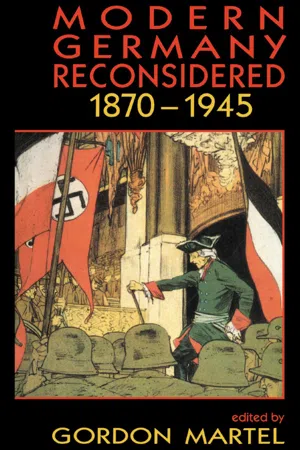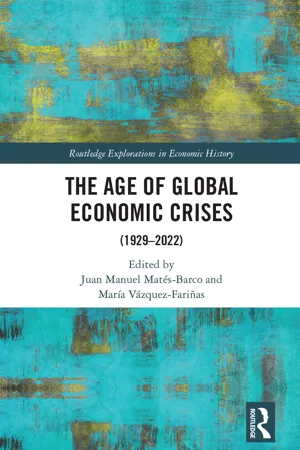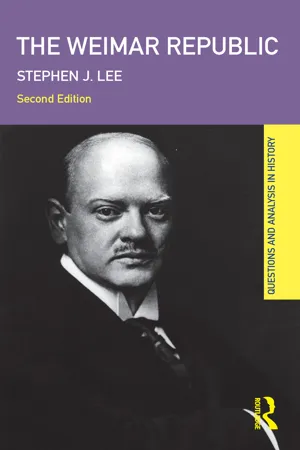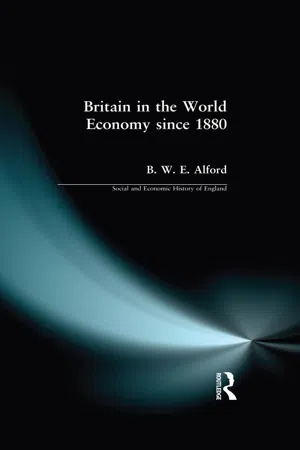History
Germany in Great Depression
During the Great Depression, Germany experienced severe economic hardship marked by high unemployment, hyperinflation, and political instability. The economic crisis contributed to social unrest and political extremism, ultimately paving the way for the rise of the Nazi Party and Adolf Hitler's ascent to power. The Depression had a profound and lasting impact on Germany's economy, society, and politics.
Written by Perlego with AI-assistance
Related key terms
Related key terms
1 of 4
Related key terms
1 of 3
8 Key excerpts on "Germany in Great Depression"
- eBook - ePub
Modern Germany Reconsidered
1870-1945
- Gordon Martel, Gordon Martel(Authors)
- 2002(Publication Date)
- Routledge(Publisher)
11
The Economic Dimension in German History
FRANK B.TIPTONEine Industrie lä ß t sich nicht von heute auf morgen schaffen.Ernst Engel.1INTRODUCTION
As both an economic and a political great power Germany has been at the center of the forces shaping the modern world, though in an oddly contradictory way. Economically, despite the wrenching interruptions of depression and war, Germany stands out as an obvious success when measured against any of the economist’s standard yardsticks. Equally obviously, in the political realm Germany became the home of the most gruesome failure in world history. The nature of the connection between economic success and political failure has compelled the attention of many historians. However, none of those who attempt to link the development of German capitalism to the rise of Nazism has won general acceptance for their arguments, regardless of whether they believe that Germany was excessively capitalistic, or that Germany was not capitalist enough. Consideration of more limited questions has not fared much better. Numbers of scholars have argued that specific changes in Germany’s political constitution exercised decisive influence on the economy, for instance with the foundation of the Bismarckian empire in 1871, the Nazi seizure of power in 1933 and the ‘Nazi economic recovery’, or the ‘zero hour’ of 1945 and the ‘ Wirtschaftswunder’ in the West German Federal Republic. On the other hand, on other occasions economic development is held to have led to a political transformation. The Great Depression of 1873–95, the inflation of 1923 and the economic collapse of 1929 have all been cited in this way. However, unification, the Nazi economic recovery and ‘ zero hour’ all tend to fade away when subjected to closer analysis, and the asserted impact of economic crises on political life also appear less certain when examined in detail. - eBook - ePub
- Martin Kitchen(Author)
- 2019(Publication Date)
- Routledge(Publisher)
7 THE IMPACT OF THE GREAT DEPRESSION 1873–1895The Political Consequences of the Depression
As historians compile and analyse the statistical data of the period, the picture of the Great Depression becomes ever more differentiated, complex and contradictory, to the point where it has been seriously suggested that the term ‘Great Depression’ is without any analytical value. As far as the experience of Germany is concerned, the simple dating of the Great Depression from 1873 to 1896, with a first period to early 1879, a brief period of modest recovery to January 1882 and a second period of depression to 1896, has some value as a means of sorting out the available material into manageable periods. It tends, however, to magnify the effects of the depression, to overlook the degree to which many key factors in the period such as the effects of overseas trade, changes in the terms of trade or the fall in prices were set in motion before the onset of the depression. But in psychological terms there can be no doubt that there was indeed a depression. The economic hangover after the heady days of the foundation of the Reich plunged businessmen into the darkest gloom. Contemporaries were unanimous in their opinion that times were bad and were getting worse, and that industrial capitalism fluctuated between times of prosperity, when the workers made outrageous demands and the prices of raw materials rose, and depression, when business was forced to cut its own throat with price reductions, production restrictions and low profits.In large part this was due to the exceptional performance of the economy in the boom years since 1848. Temporary set-backs in 1857 and 1866 were only short interruptions in almost thirty years of high profits and rapid expansion. The depression showed that industrial capitalism was not necessarily synonymous with endless expansion and boundless prosperity. Nor was the structure of the German economy an unchanging and immutable fact, for it had to make major and often painful adjustments in order to accommodate itself to the changing world economic situation. - eBook - ePub
- Walter Rinderle, Bernard Norling(Authors)
- 2021(Publication Date)
- The University Press of Kentucky(Publisher)
5
THE GREAT DEPRESSION
FOR THOSE PEOPLE in the Western world who were personally maimed in one of the wars of the twentieth century and for those who lost a father, husband, brother, or son in one of those conflicts, the war in question has ordinarily been the most vivid public event in their memories. For anyone else born before 1925 such has not usually been the case. For them, eclipsing all the wars has been the memory of the Great Depression of the early 1930s. For many, perhaps most, of the farmers in Germany the Great Depression seemed to portend inexorable ruin. Demand for agricultural products fell below even the subnormal level of the 1920s, prices dropped still further, health services were restricted, state unemployment compensation gradually ran out, and the chronically unemployed had to be transferred to makeshift forms of communal aid. For millions, destitution seemed imminent. No other event of modern times (before 1960) touched so many, or imprinted itself so indelibly on their imaginations: not World War I, not World War II, not the French occupation of 1923 nor that of 1945, not even the catastrophic inflation of 1923.It might be objected that this characterization is overdrawn: that the psychological shock of the Depression was greater in the United States than in Germany because most Americans believed that they lived in a unique “land of opportunity,” whereas most Germans did not; that more Americans than Germans committed suicide in the Depression years; that Americans were more chagrined than Germans at having to accept public assistance or to help extended families. Such contentions, while true, seem less than decisive. Tens of millions of American farmers and day laborers were quite as well acquainted with habitual poverty as their German counterparts. American suicides were mostly losers in stock market speculation. Different German attitudes about family aid owed to different historical traditions. Lower sensitivity to receiving welfare reflected mostly the consideration that, by the 1930s, Germans had passed farther down the road toward the welfare state than had Americans. It is hard to resist the general view that Germany was hit harder by the Depression than any other major Western country. Only there, after all, did gang fights, street rioting, and political assassinations become widespread - eBook - ePub
The Age of Global Economic Crises
(1929-2022)
- Juan Manuel Matés-Barco, María Vázquez-Fariñas, Juan Manuel Matés-Barco, María Vázquez-Fariñas(Authors)
- 2023(Publication Date)
- Routledge(Publisher)
1 The Great Depression of 1929 Crisis in the world economyJuan Manuel Matés-BarcoDOI: 10.4324/9781003388128-11.1 The Western economy in the early 20th century
The 20th century was marked by dramatic upheavals: two world wars – of great severity and destruction – and several economic crises. The interwar period (1918–1939) ran from the end of the First World War to the beginning of the Second World War. During these years, two events stand out: the birth of the Soviet Union and the economic crisis of 1929. In this chapter, we will deal with the second of these events.The outbreak of the First World War upset the international equilibrium of the early years of the 20th century. Until 1914, the political rivalry of the great powers had not generated tensions of such scope and gravity. From that year onwards, events far outstripped the attitudes of politicians and rulers (Casanova 2011). After an acute post-war crisis followed by a short depression in 1920, the industrialised countries of the West benefited from a period of expansion that lasted until 1929 (Aldcroft 1989). Political, social, and economic life had weakened in Europe, and some countries were on the verge of bankruptcy in the early post-war period. Growth during these years was very uneven. Britain suffered through a precarious situation after the deflationary experience of 1925, which led to a return to the gold standard; France endured tremendous instability; and Germany was plagued by terrible hyperinflation. In Spain, economic growth was similar to that experienced in the rest of Europe and coincided with the favourable international environment after the war. However, by 1930, the difference in Spanish GDP per capita compared to the most advanced countries was still considerable (Carreras and Tafunell 2010; Sánchez and Catalán 2013). The fragile foundations of the Roaring Twenties - eBook - ePub
From Unification to Nazism
Reinterpreting the German Past
- Eley Geoff(Author)
- 2019(Publication Date)
- Routledge(Publisher)
after the real period of depression in the 1870s, certainly outlived the overall period 1873–96, and in many ways only fully appeared in the 1890s and after.V
It will be clear from the general drift of my remarks that I think the political impact of the Great Depression has been greatly overstated, and given the space I would argue that the 1890s witnessed a far greater change in the character of the political system.31 The status of the ‘Great Depression’ as a meaningful period is itself rather doubtful, and still awaits systematic discussion amongst German economic historians. Similarly, the longer view elaborated upon it, that between 1873 and 1896 developments were laid down that culminated several decades later in the triumph of fascism, also needs to be more adequately expressed. The suggestion that as a result of the Great Depression some old authoritarian structures became deeply entrenched and certain new ones created, partly by the clever manipulations of the ‘old élites’ and partly by the social psychological effects of popular disorientation in a period of accelerated and irregular industrialization, has become a well-worn convention of much German historiography. But the idea that ‘prefascist’ potentialities were thereby unleashed, to be strengthened by the manipulations and mobilizations of the Wilhelmine era, is ultimately too glib and question-begging an interpretation. As I argue in the concluding essay of this collection, this encourages the belief that fascism was preordained by malformations in the initial stages of capitalist industrialization. It resulted from the incompleteness of the original societal transformation, when too many features of the ‘pre-industrial’ society were left intact which should have been swept away, and not from the authentic contradictions of an advanced capitalist society itself.32 - eBook - ePub
- Stephen J. Lee(Author)
- 2013(Publication Date)
- Routledge(Publisher)
According to Bookbinder, ‘By 1929 Germany had become the world’s second industrial power behind the United States. Real wages rose, and the standard of living for many increased dramatically’. 3 The corollary to this is that any real threat to Germany’s economic stability would be external, not internal. Snyder sees the essential cause of ‘the next economic crisis’ in ‘the world depression of 1929’, which ‘hit Germany with tremendous impact’. 4 There is, however, a danger even in this approach. It sees economic collapse as monocausal. There must be an alternative perspective. If the Depression which followed the Wall Street Crash exercised such a profound impact on the German economy, there must have been a faultline within that economy. The answer could be that the recovery after 1923 was based far too heavily on externally-generated credit. American investments were bound to be highly attractive since they offered an easy alternative to having to increase domestic taxation. They were also used in a dangerous way. Short-term loans were used to finance long-term capital projects, the assumption being that it would not be difficult to renew the loans as payments fell due. This made Germany highly vulnerable to any major fluctuation on the American stock market; following the Wall Street Crash most short-term loans were recalled. This explanation is enough to satisfy some historians. The German economy was sound apart from this one flaw — the one which, in the circumstances, proved fatal. But can we agree even with this? We still have a monocausal analysis: a single external factor reacting with a single source of internal vulnerability - eBook - ePub
Twentieth-Century Europe
A Brief History, 1900 to the Present
- (Author)
- 2014(Publication Date)
- Wiley-Blackwell(Publisher)
A hidden weakness in the postwar European economy was its dependence upon American finances. The great prosperity of the period 1924–1929 was financed by American loans, while the prosperity of America itself was financed by credit. In 1924, the American financier Charles Dawes (1865–1951) chaired a committee that produced the Dawes Plan for the payment of reparations by Germany. Included in the plan were arrangements for an immediate loan of 800 million gold marks. By 1925, American banks had loaned Germany three billion gold marks. More money flowed into Germany between 1924 and 1929 in the form of loans than flowed out as reparations payments. The German economy prospered, and that prosperity bubbled over into the rest of Europe, as money flowed in a circle from the United States to Germany in the form of loans, to France and Great Britain in the form of reparations payments, and back to the United States as payment of war debts. European prosperity in the “Roaring Twenties,” like that of America, was based more on speculation than on production and consumption of goods and services. If anything should disrupt the flow of credit, the whole edifice would collapse. And so it did between 1929 and 1932.The prosperity of the 1920s was based upon speculation in stocks, often purchased on “margin” (on credit) with the stocks themselves serving as collateral. Although even some working-class people speculated in stocks, most workers did not share in the prosperity. Wages remained low for workers, which, together with the depressed agricultural sector, meant that the purchasing power of the masses could not keep up with production—in short, workers did not earn enough to afford to purchase the products they made. The collapse of the stock market set in motion a vicious cycle, as the financial crisis became an industrial crisis. Bank failures led to the closing of factories and rising rates of unemployment. As unemployment spread, further reductions in production and plant closings followed. Factories cannot produce what the public cannot afford to purchase.The Great Depression spread from America to Europe. Already in 1928, Americans were withdrawing funds from Europe to invest in stocks. As the Depression struck, Americans ceased investing in Europe and began to withdraw funds from European banks in great quantities. Hardest hit were banks in Germany and Central Europe. The decline in American industrial productivity, the withdrawal of American capital from the world market, and the low prices paid for agricultural products and raw materials combined to reduce production, trade, and the movement of capital everywhere. - eBook - ePub
- Bernard W.E. Alford(Author)
- 2014(Publication Date)
- Routledge(Publisher)
Nevertheless, the rising economic power of other nations, especially that of Germany, had clearly been recognized as a matter of concern in Britain for some time, and the severity of their subsequent economic problems gave rise to an attitude of Schadenfreude that provided a kind of vicarious reassurance that, after all, the British economy had proved to be more stable and durable than its major rivals. But even under these conditions Britain’s position in world trade continued to slide. 24. James, The German Slump. 25. An excellent short account is J. Potter, The American Economy Between the Wars (1974). A good basic text is P. Fearon, War, Prosperity and Depression. The US Economy 1917–45 (Oxford, 1987). Table 5.6 UK comparative trade shares, 1929 and 1937 (% world total) As to the broader picture of economic and social change, some historians claim that during the 1930s there were important developments in state provision of welfare benefits, reflecting the emergence of new principles of social policy which expanded to form the basis of post-Second World War welfare state. 26 Yet to the extent that there were changes, they did not involve significant costs or anything that could be described as radical institutional reform. To the contrary, the stress on the need for economic stability and orthodoxy enormously strengthened the traditional institutions of government, especially the Treasury. And, somewhat ironically, social pressures were eased by the favourable movement in the terms of trade. Despite Britain’s poor export performance, the price of imported foodstuffs, in particular, fell dramatically, with a consequent effect on real incomes for the mass of the people. Agricultural depression, which was such a major destabilizing force in many countries, had only a weak effect in Britain because of the contraction in the industry that had occurred much earlier as part of the process of the development of an export economy
Index pages curate the most relevant extracts from our library of academic textbooks. They’ve been created using an in-house natural language model (NLM), each adding context and meaning to key research topics.
Explore more topic indexes
Explore more topic indexes
1 of 6
Explore more topic indexes
1 of 4







